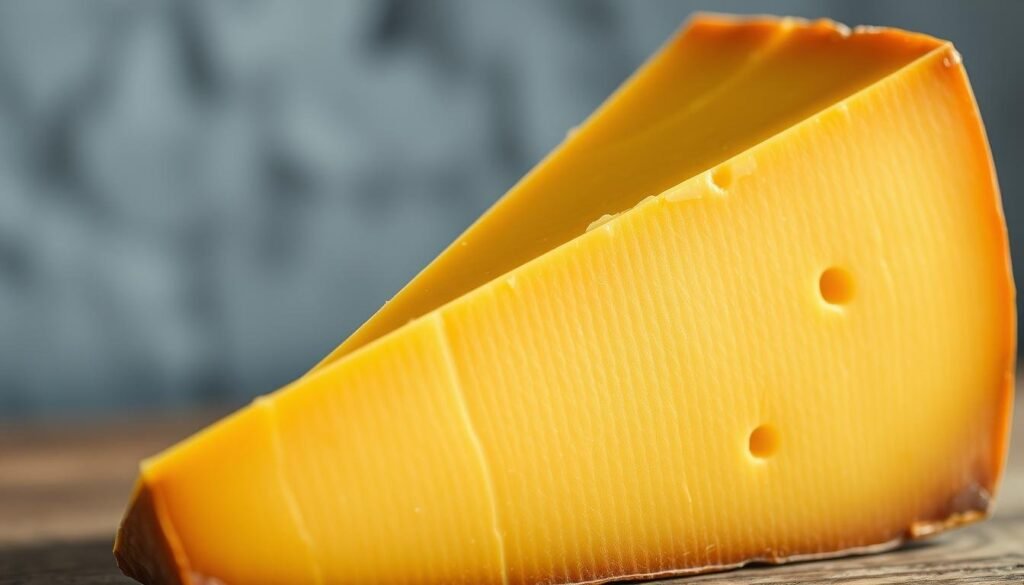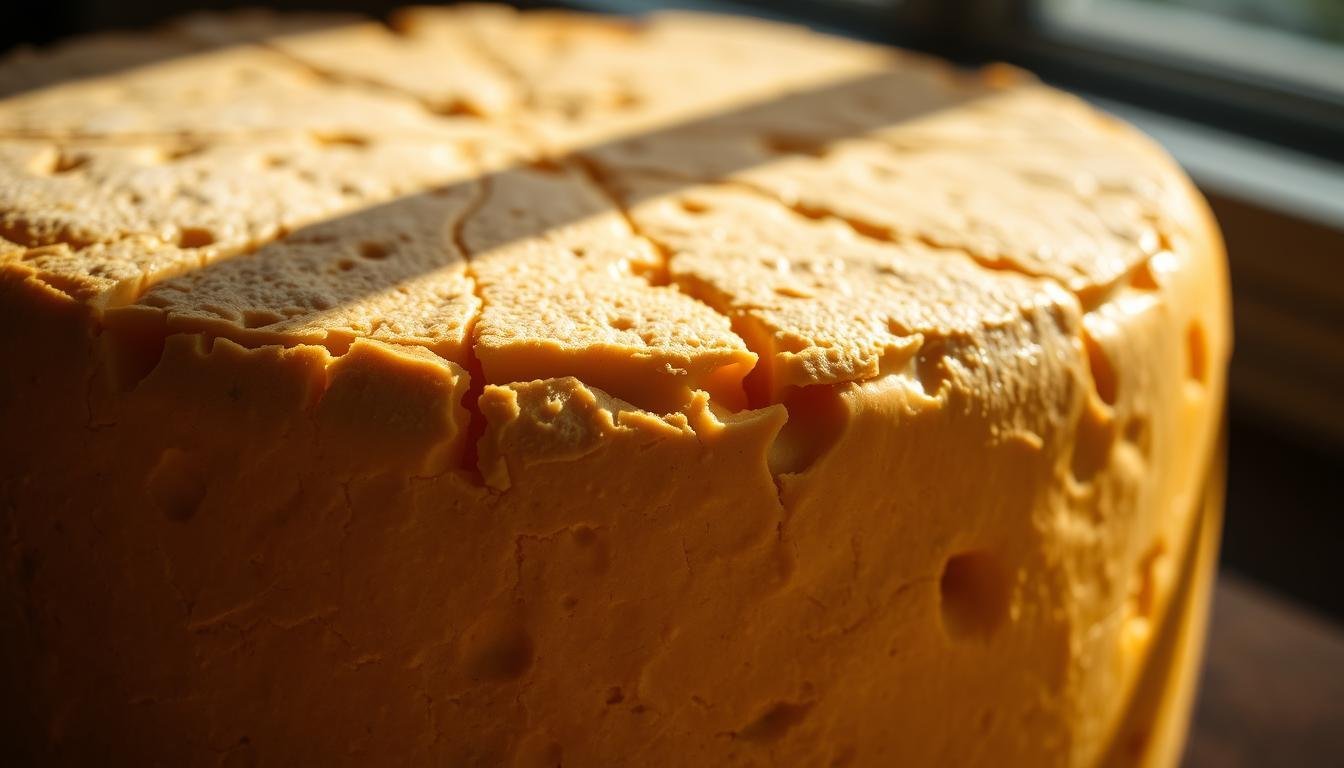Manchego cheese comes from Spain and is known for its rich, nutty taste and firm texture. As someone who loves cheese, you might wonder about the rind that covers it.
The rind is a natural part of the cheese’s aging process. It often makes people ask if it’s safe to eat. Does it improve the taste or texture? Knowing about the rind is key to enjoying Manchego cheese fully.
In this article, we’ll look into whether you can eat the rind of Manchego cheese. We’ll also talk about its benefits and how it can make your food better.
Contents
- 1 What Is Manchego Cheese?
- 2 Understanding Cheese Rinds
- 3 Can You Eat the Rind on Manchego Cheese?
- 4 Benefits of Eating Manchego Cheese Rind
- 5 Preparing and Serving Manchego with the Rind
- 6 Conclusion
- 7 FAQ
- 7.1 What is Manchego cheese made of?
- 7.2 Is Manchego cheese rind edible?
- 7.3 What are the benefits of eating Manchego cheese rind?
- 7.4 How do you serve Manchego cheese with the rind?
- 7.5 Can you eat the rind of aged Manchego cheese?
- 7.6 Are there any safety concerns when eating Manchego cheese rind?
- 7.7 Can you use Manchego cheese rind in cooking?
What Is Manchego Cheese?
Manchego cheese is a well-known Spanish cheese. It comes from the La Mancha region, where Manchega sheep graze. The dry climate and special plants of La Mancha give the cheese its unique taste.
Making Manchego cheese is a traditional method. It starts with curdling sheep’s milk with natural rennet. Then, the cheese is pressed and aged for months to a year or more. This aging process is key to its flavor and texture. Manchego cheese benefits include its nutritional value and versatility in cooking.
The cheese has a firm, crumbly texture and a rich, nutty taste. It’s loved by cheese lovers. Manchego cheese is great as a table cheese, in cooking, or grated over dishes. Knowing how it’s made shows the skill that goes into creating this cheese.
| Characteristics | Description |
|---|---|
| Milk Source | Manchega Sheep |
| Region | La Mancha, Spain |
| Texture | Firm, Crumbly |
| Flavor Profile | Rich, Nutty |
| Aging Process | Several months to a year or more |
Understanding Cheese Rinds
Learning about the rind on your cheese can make you appreciate it more. Cheese rinds are not just for protection. They also tell you about the cheese’s type, age, and how it was made.
There are many types of cheese rinds, each with its own traits. They fall into two main groups: natural and washed rinds.
Natural vs. Washed Rinds
Natural rinds form as the cheese ages and dries out. This creates a hard, crusty exterior. You’ll often find this on cheeses like Parmigiano-Reggiano.
Washed rinds, however, get treated with brine, wine, or other liquids. This makes the rind orange or red and gives it a bolder taste. Cheeses like Limburger and Epoisses have this type of rind.
| Rind Type | Description | Examples |
|---|---|---|
| Natural | Formed through drying during aging | Parmigiano-Reggiano, Cheddar |
| Washed | Treating with liquids during aging | Limburger, Epoisses |
When it comes to cheese rind safety, most rinds are okay to eat. But, how tasty they are can vary. Natural rinds are usually safe and can be eaten. Washed rinds, while safe, might be too intense for some.
Knowing about the types of cheese rinds can make you enjoy cheese more. It also tells you about the rind’s safety and uses. Whether you eat the rind or not, understanding it can make your cheese experience better.
Can You Eat the Rind on Manchego Cheese?
Many people wonder if they can eat the rind on Manchego cheese. This cheese comes from Spain and is loved for its strong taste and firm texture. The rind forms during the aging process.
The rind on Manchego cheese is safe to eat. It’s covered in a natural wax or mold that grows as it ages. This coating not only keeps the cheese safe but also makes it taste better.
The rind is shaped by the cheese’s aging process. It’s turned and rubbed with brine or other substances to stop mold from growing. These steps help create the rind.
To sum up, the rind on Manchego cheese is not only safe but also enhances the taste. Whether you’re a cheese lover or just enjoy Manchego, you can eat it with the rind without worry.
Benefits of Eating Manchego Cheese Rind
The rind on Manchego cheese is packed with nutritional benefits. Eating it adds to the enjoyment of the cheese. It also brings several health perks.
Manchego cheese rind is a good source of protein and calcium. These nutrients are essential for your body. The rind also has compounds that boost the taste and texture of your food.

Eating the rind of Manchego cheese makes your cheese-eating experience better. It adds a unique texture and flavor. This complements the cheese’s softer inside, making it more complex and rich.
Some key benefits of eating Manchego cheese rind include:
- Increased nutrient intake, including protein and calcium
- Enhanced flavor and texture experience
- A more satisfying and enjoyable eating experience
To safely enjoy Manchego cheese rind, make sure the cheese is aged and handled right. Proper aging and handling reduce the risk of contamination. This makes the rind safe to eat.
Preparing and Serving Manchego with the Rind
To fully appreciate Manchego cheese, it’s key to know how to prepare and serve it with the rind. The rind is a natural part of the cheese’s aging process. It adds to its unique flavor and texture.
When preparing Manchego cheese, you have several options to enhance its natural flavors. You can serve it as is, or you can incorporate it into various dishes. Here are some ideas:
- Slice the Manchego thinly and serve it with membrillo, a sweet quince paste, to balance the savory flavors of the cheese.
- Use Manchego in salads, where its nutty flavor can complement greens and other ingredients.
- Grate the Manchego over pasta dishes or soups for an added depth of flavor.
When serving Manchego with the rind, presentation matters. Consider the following tips to enhance your dining experience:
| Serving Suggestion | Description |
|---|---|
| Cheese Board | Include Manchego with the rind on a cheese board, accompanied by crackers, fruits, and nuts. |
| Tapas | Serve sliced Manchego with olives and cured meats as part of a tapas selection. |
| Dessert Pairing | Pair Manchego with sweet items like honey or fig jam for a contrasting flavor experience. |
For those new to eating cheese rinds, Manchego is a great starting point. Its rind is relatively mild and adds a pleasant texture to the cheese-eating experience. When you’re ready to get creative, try incorporating Manchego into your recipes, such as grating it over dishes or melting it into sauces.
Tips for Enjoying Manchego Cheese Rind
To get the most out of your Manchego cheese, consider the following:
- Store Manchego properly to preserve its flavor and texture. Keep it in the refrigerator, wrapped in wax paper or aluminum foil.
- Allow the cheese to come to room temperature before serving to enhance its flavors.
- Experiment with different pairings to find your favorite way to enjoy Manchego with the rind.
By following these tips and ideas, you can enjoy Manchego cheese with the rind to its fullest potential. Explore a rich and nuanced gastronomic experience.
Conclusion
Now that you’ve learned about Manchego cheese, you might wonder if you can eat the rind. The answer is yes, you can. The rind is not only safe to eat but also full of flavor and nutrients.
Eating the rind adds to the joy of enjoying Manchego cheese. It lets you fully experience the rich taste of this Spanish cheese. Whether you’re having it as part of a tapas platter or on its own, the rind makes it even better.
Manchego cheese is great in many dishes, and its rind is a big part of its charm. So, when you’re enjoying Manchego cheese next time, make sure to include the rind too.
FAQ
What is Manchego cheese made of?
Manchego cheese comes from Manchega sheep milk. It’s from the La Mancha region in Spain. It’s known for its rich, nutty taste and firm texture.
Is Manchego cheese rind edible?
Yes, the rind of Manchego cheese is safe to eat. It’s a natural part of the cheese.
What are the benefits of eating Manchego cheese rind?
Eating the rind adds texture and flavor. It’s also full of antioxidants. These may have health benefits.
How do you serve Manchego cheese with the rind?
Serve Manchego cheese with the rind on a cheese board. Slice it thinly or pair it with membrillo. It’s great grated over salads or pasta.
Can you eat the rind of aged Manchego cheese?
Yes, the rind of aged Manchego cheese is edible. Aging makes the rind’s flavors even more delicious.
Are there any safety concerns when eating Manchego cheese rind?
Always handle and store Manchego cheese right to avoid contamination. If you see mold beyond the rind, it’s best to throw it away.
Can you use Manchego cheese rind in cooking?
Yes, use Manchego cheese rind in soups, stews, or braises. Chop it finely and add it for extra umami flavor.

Hello, I am Bellamy George, a certified nutritionist and food safety specialist from Springfield, IL. With a degree in Food Science, I share research-backed insights on edible foods, seeds, and seafood for safe, informed eating.

